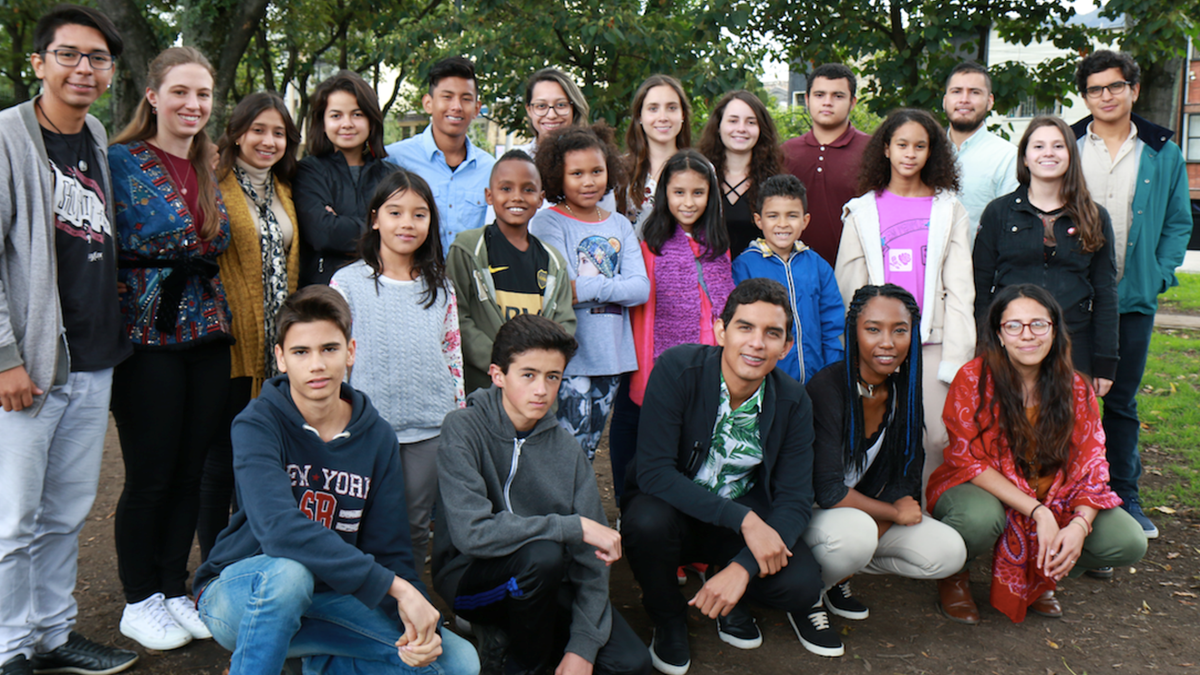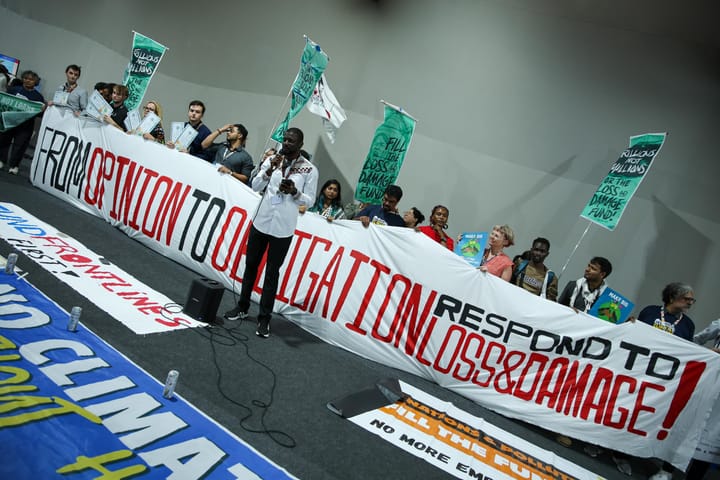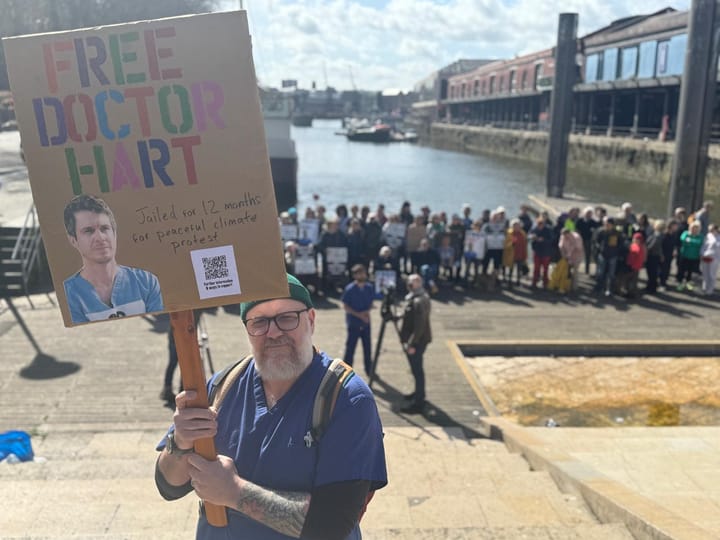'The kids that demanded accountability': Colombian future generations lawsuit seven years on

The end of 2016 was a big moment in Colombian history. A landmark peace deal between the government and Revolutionary Armed Forces of Colombia (FARC) had finally been signed, ending South America’s longest internal armed conflict. It was a moment of real optimism, recalls Gabriela Eslava Bejarano, a lawyer who had recently started working as a researcher for Colombian human rights NGO Dejusticia.
Bejarano was familiar with strategic litigation, having worked on cases such as consumer rights to information on sugary drinks and fishermen seeking redress for the damaged ecosystem of a coastal lagoon. She was also just 25, a bike-riding vegan with her entire future head of her. So when her director tasked her with thinking about climate change from a litigation perspective, the idea appealed both professionally and personally.
Trusting our children
Speaking to The Wave in a personal capacity, Bejarano recalls filling a spreadsheet with examples of climate lawsuits around the world. “There were a lot. I remember finding the Juliana case in the US and that was super interesting. We followed the narrative of the case very closely, although our intention wasn't to copy it, but more to see if something like that was possible in our context.”
A lawsuit brought by a group of older ladies against the Swiss government (later to lead to the European Court of Human Rights’ first ruling against a state over climate change) got the team thinking creatively about who could be a plaintiff in a case like this.
They identified the Colombian municipalities most vulnerable to the effects of climate change and scoured their networks for environmental leaders in each of those places.
Eventually 25 “beautiful young people” between the ages of 7 and 26 signed up, says Bejarano. All were active within their communities in some way, whether studying an environmental subject at university or running a recycling group at school, so could prove they cared deeply about the subject. "If they were above 18, they would sign themselves. If they were below 18, we would talk to their parents.”
"I understood the importance of this fight as mine. I understood that we are all interconnected."
One of those young people was 23-year-old Yurshell Rodríguez Hooker from Providencia, an island in the Caribbean Sea owned by Colombia and home to the Earth’s third-longest barrier reef system.
Hooker tells The Wave that she had already faced the devastation of climate change in her short lifetime, losing her home to hurricanes and witnessing dying coral. “As a young Afro-Indigenous Raizal woman from the Caribbean I felt it was my responsibility to join the movement that was demanding accountability from the government and to be part of the fight to protect our land, our people and our future."
By now it was 2018 and climate litigation was taking off around the world. The lawsuit also rode on a wave of domestic optimism created by the FARC peace deal, says Bejarano. The accord drew a line in the country’s history which they could claim marked them out as a distinct generation with its own priorities.
The lawsuit that Dejusticia filed on behalf of the 25 plaintiffs is called a tutela - a legal complaint that any Colombian citizen can file if they believe their fundamental rights are under threat.
Bejarano was both an attorney on the case and one of the two oldest plaintiffs, which meant she could go directly to the judge to ask how the case was going. “It was a privilege,” agrees Camila Bustos, a researcher at Dejusticia at the time who also played this double role.
Flying rivers
The team looked into Colombia’s contribution to greenhouse gases, expecting to trace the source to industry or transport. Instead they found government reports identifying deforestation in the Colombian Amazon as the clear main cause. Tens of thousands of hectares were already being destroyed every year but deforestation rates soared after the peace deal, particularly in remote rainforest areas once controlled by guerillas. “For the past seven years, it has been very common to hear about deforestation,” says Bejarano. “But in 2017 very few people were talking about [it].”
The young plaintiffs had already made this link. "Although I am from Providencia, far from the Amazon, I understood the importance of this fight as mine," says Hooker. "I understood that we are all interconnected."
The next step was to connect what was happening in the rainforest, down in the south of the country, with the reality in the capital where 15% of the country lives, including its decision-makers. With the help of Colombian climate scientists, they leapt on the concept of ‘flying rivers’, the movement of vast amounts of water vapour through the air from the Amazon basin to places such as Bogotá, to show how intrinsically connected the two ecosystems were.
This fact became an important part of the lawsuit, but they were keen to avoid being too technical. So they added a section outlining five key principles: precaution, participation, intergenerational equity, solidarity and the best interests of children.
“The one that was most important to me was solidarity,” says Bejarano. “We're trying to convince the judge that something that's happening in 2017 is going to affect people who expect to be alive in 2040. For us, solidarity means three things: solidarity with those who live with us right now and with whom we share the same time and space; solidarity with those who are not here but are going to be alive sometime in the future; and solidarity with other sentient beings.”
With all this, the team felt it had enough evidence to file their tutela.
It claimed that continuing deforestation was a breach of the government’s duties to the 25 plaintiffs. Central to the argument was that their right to a healthy environment, enshrined in the Colombian constitution, was under threat. They also argued that deforestation and its subsequent climate and environmental impacts breached the plaintiffs’ rights as a future generation to life, health, water and food.
Because this was about potential violations of fundamental rights, the court had just ten days to respond. “Now that I look back, I don't know how we were brave enough to tell a judge that we strongly believe that we're going to be the first generation that was going to be able to live in peace in Colombia, so we have the right to actually consider that a healthy environment was something that should be protected," says Bejarano.
They lost. Two of the judges did not believe this was the right legal mechanism to use. But the third agreed with their arguments in a strong dissenting opinion that gave them enough hope to appeal. “That person understood what we were trying to do,” says Bejarano.
“I don't think we were special people to bring the case... the context is also very important.”
Despite the novelty of the lawsuit, Bejarano is wary of putting the NGO or plaintiffs on a pedestal. “I don't think we were special people to bring the case,” she says. “I think the context is also very important.”
The Supreme Court had 20 days to decide on a tutela once it received it and time was running out. It asked for an extension to mull the matter over Easter, an important time for a devoutly Catholic country which was taking note of Pope Francis’ ongoing climate justice advocacy. Prominent climate scientist James Hansen also wrote an amicus brief supporting the case.
On 5 April 2018, the Supreme Court upheld the complaint (key excerpts here). It said future generations have the right to a healthy environment. It said authorities at different levels had breached their duties and gave them orders to meet within months. And it went beyond the initial request in declaring the Amazon rainforest itself as a subject of rights.
It was a massive and unexpected decision. “We were running around the office and screaming," laughs Bustos.
It was Colombia’s first climate litigation win and one of the first successful cases outside the Global North. As a result it made headlines around the world, many focused on the rights of the Amazon. Michael Gerrard, director of the Sabin Center for Climate Change Law at Columbia University, described it as “one of the most solid environmental judgments that any court in the world has dictated”.
“It felt like a shared victory,” says Hooker. There were immediate concerns about the impact of the ruling and the tough timetable the court had ordered public bodies to meet. “But the energy of the communities and the rise in 2018 of the movement that were advocating for [the] environment made it clear that we would continue pushing forward.”
At home, Dejusticia started talking to the government about how the decision should be implemented, and the discussions seemed to be reasonably positive. But then elections took place and the new administration under the populist Iván Duque had a different approach to both peace and deforestation.
Missing plans
According to Natalia Escobar, principal environmental justice researcher at Dejusticia, there are two ways of looking whether the case was successful: whether authorities complied with the court’s actual orders and whether it managed to prevent deforestation.
From the first perspective, it has clearly not been fully implemented.
The first order was that the federal government must present a plan of action to reduce deforestation in the Colombian Amazon within four months. In fact, work on such a plan did not start for years and, although it is now finally in progress, it has not yet finished.
The second order was that the presidency and the ministries of environment and agriculture must create an ‘intergenerational pact for the life of the Colombian Amazon’ with the participation of the plaintiffs, affected communities, and research and scientific organisations. That plan, known as the PIVAC, is also still in development with no draft available publicly yet.
The third order was that municipalities in the Amazon must update their land-use plans. Escobar says about a third of the 70 or so relevant municipalities have done so.
The fourth order was to the Amazon’s five environmental authorities, known as regional autonomous corporations, to issue deforestation action plans. The government claims this has been done, although only one, that of the CDA, can be found online. Escobar says there is no mechanism for reviewing or updating these plans, and what exists does not have proper baselines, so cannot be properly monitored.
Seeing the wood past the trees
The other way of looking at the ruling is to examine what happened to Colombia’s rainforest.
Colombia’s peace agreement initially led to an increase in deforestation as conflict was replaced with cattle and land grabs by armed groups filling the void left by FARC. Government efforts to curb the problem seemed to become more serious after the election of Gustavo Petro in 2022 and deforestation reached a historic low in 2023.
But early this year Colombia reported a sharp rise again - perhaps as much as a 50% increase in primary forest loss. Experts attribute this to a combination of illegal activities such as mining, ranching, logging and coca plantations (unlike other parts of South America where wildfire was a big driver), the levels of which are strongly linked to the state of peace talks with guerilla groups.
The government has made many changes, says Escobar, who joined Dejusticia after the lawsuit took place, so it is difficult to unravel all the different political, legal and social factors affecting deforestation rates. Her view is that the ruling was “an instrument that helped Colombia change its institutional design”, at least a little, for example by putting new bodies in place. “People started talking about deforestation when it wasn't an issue before. And we finally have jurisprudence that supports us in state discussions.”
Legal benchmark
There have been other successful Colombian climate cases. Last year, for example, the Constitutional Court agreed with activists that a law on environmental impact assessment should include considerations of climate change. But the 2018 ruling “still serves as a legal benchmark today”, says Escobar.
Bejarano also saw a change in young people being “more outspoken about protecting our environment and how it is all connected”.
What it didn’t do, says Escobar, is strengthen the rights of Amazonian people to participate in environmental matters that affect them.
Although two plaintiffs - Jose Daniel Rodriguez Pena and Felix Jeffry Rodriguez Pena - were Indigenous people from the Amazon gateway city of Leticia, and a group of Indigenous organisations sent an amicus brief to the court, Bustos says Indigenous groups felt they had been excluded from the lawsuit and the judgment, as had farmers who lived in the Amazon region.
Bejarano also recalls criticism from lawyers that not enough consultation had taken place with Indigenous communities. “That was an interpretation that was heavy for us, especially being young. You were trying to do something out of being honestly concerned about a problem in your country, and honestly thinking that you were going to be the first generation to actually have the time to think about how to protect the environment and not how to kill each other.”
If she had her time again, perhaps Bejarano would have tried to talk to more people before filing the tutela. But she stands firmly by its main arguments. “I know all of the 25 children were honest. None of us looked for anything like a personal gain - we weren't trying to become famous.”
Worse, Dejusticia says the ruling was used as an excuse to violently drive out poor campesinos and commit human rights abuses under an aggressive (and unsuccessful) military action to curb deforestation called ‘Operación Artemisa’. "Community leaders... informed us that some representatives of the army and the Attorney General's Office referred to compliance with the ruling in reference to their work protecting the Amazon," says Escobar. She says there was public confusion about the difference between the judgment and the operation, which the government fuelled.
Dejusticia is petitioning the court to make it explicit that urgent measures to tackle deforestation must still respect human rights. And it is considering further legal action.
"By prioritising nature, we lost sight of the people"
There is also wariness at the much-heralded rights given by the Supreme Court to the Amazon. Bejarano notes that this legal argument became very popular in other environmental cases for a while, with more than 20 other ecosystems in Colombia being afforded rights. “So we have rivers with rights, parks with rights, everything with rights. But we still don't have a law or a decree that creates a regulation about the rights of nature.”
“It was very important litigation for the protection of nature,” says Escobar. “But by prioritising nature, we lost sight of the people.” Dejusticia is considering how to better understand the rights of nature concept, which is now a rapidly growing global movement, but at the moment it does not believe it is the best legal path for climate protection in Colombia.
Seven years after the ruling, initial optimism about the peace deal has been replaced by fear of a new swathe of armed groups and concern that the country could risk re-running its violent past.
Meanwhile, the lawsuit has proved prescient; Bogota citizens recently lived through a whole year of water rationing during a prolonged drought made worse by climate change and one that was predicted in the tutela. “No one will go back to that to tell us ‘Look these kids were already talking about that’,” says Bejarano.
However, it did change the lives of many of the plaintiffs, some of whom are now parents themselves - stewards of another new generation. Younger members became involved with Fridays for Future school strikes in 2019; older ones went on to careers in biology and history. Bustos was inspired to study law and specialise in environmental justice; she is now assistant professor of law at the Elisabeth Haub School of Law at Pace University.
Hooker, now an environmental engineer, says being involved in the lawsuit had a “profound impact” on her. “It confirmed my path as an environmental activist and deepened my commitment to protecting our ecosystems. It reinforced the idea that we must be at the forefront of environmental justice - not just as a theory, but as something that requires action.”
The plaintiffs have stayed in touch with each other and are still trying to advance the intergenerational PIVAC document as ordered by the court.
Hooker says people still remember the judgment, which “became a reference point for environmental and Indigenous rights movements”. “People often refer to it as the kids that really began to demand accountability, and I’m proud to have been part of that momentum.”
By contrast, it left Bejarano with a degree of disillusion and a career change into financial sustainability. “Sometimes lawyers only think about the evidence and the words, but we don't spend that much time thinking about how is this going to be implemented? How are we going to support those entities who are responsible for actually making our courts’ decisions come to life? It's not only about asking the government to protect your rights - what elements, what budgets are available for them to make things real?
“This is the only time in my life that I have put all my heart into something that brings good things, but that also drains a bit. And I felt that law wasn't enough to actually bring change,” she says, coming to a similar conclusion to Asghar Leghari, who fronted a landmark climate lawsuit in Pakistan. “At the end of the day, I realised that you can have a very nice and well-written decision by a Supreme Court and nothing changes.”


